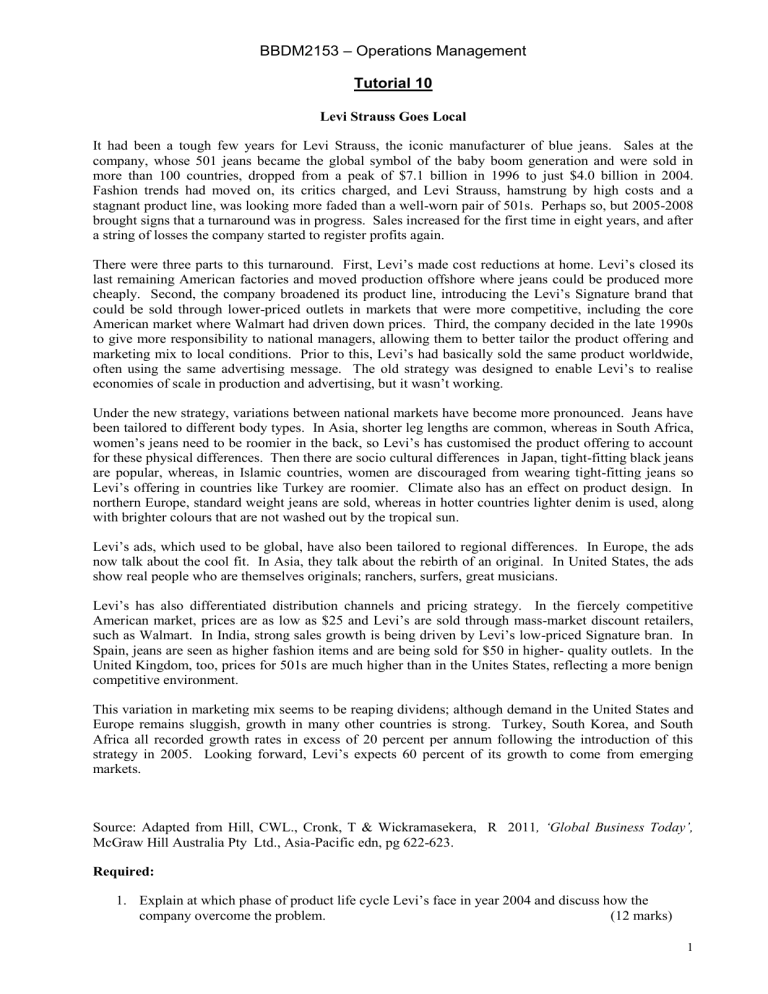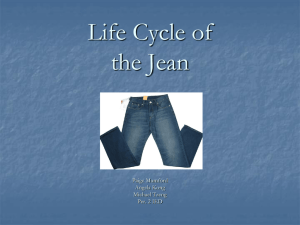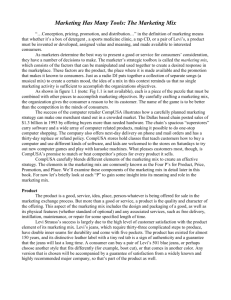
BBDM2153 – Operations Management Tutorial 10 Levi Strauss Goes Local It had been a tough few years for Levi Strauss, the iconic manufacturer of blue jeans. Sales at the company, whose 501 jeans became the global symbol of the baby boom generation and were sold in more than 100 countries, dropped from a peak of $7.1 billion in 1996 to just $4.0 billion in 2004. Fashion trends had moved on, its critics charged, and Levi Strauss, hamstrung by high costs and a stagnant product line, was looking more faded than a well-worn pair of 501s. Perhaps so, but 2005-2008 brought signs that a turnaround was in progress. Sales increased for the first time in eight years, and after a string of losses the company started to register profits again. There were three parts to this turnaround. First, Levi’s made cost reductions at home. Levi’s closed its last remaining American factories and moved production offshore where jeans could be produced more cheaply. Second, the company broadened its product line, introducing the Levi’s Signature brand that could be sold through lower-priced outlets in markets that were more competitive, including the core American market where Walmart had driven down prices. Third, the company decided in the late 1990s to give more responsibility to national managers, allowing them to better tailor the product offering and marketing mix to local conditions. Prior to this, Levi’s had basically sold the same product worldwide, often using the same advertising message. The old strategy was designed to enable Levi’s to realise economies of scale in production and advertising, but it wasn’t working. Under the new strategy, variations between national markets have become more pronounced. Jeans have been tailored to different body types. In Asia, shorter leg lengths are common, whereas in South Africa, women’s jeans need to be roomier in the back, so Levi’s has customised the product offering to account for these physical differences. Then there are socio cultural differences in Japan, tight-fitting black jeans are popular, whereas, in Islamic countries, women are discouraged from wearing tight-fitting jeans so Levi’s offering in countries like Turkey are roomier. Climate also has an effect on product design. In northern Europe, standard weight jeans are sold, whereas in hotter countries lighter denim is used, along with brighter colours that are not washed out by the tropical sun. Levi’s ads, which used to be global, have also been tailored to regional differences. In Europe, the ads now talk about the cool fit. In Asia, they talk about the rebirth of an original. In United States, the ads show real people who are themselves originals; ranchers, surfers, great musicians. Levi’s has also differentiated distribution channels and pricing strategy. In the fiercely competitive American market, prices are as low as $25 and Levi’s are sold through mass-market discount retailers, such as Walmart. In India, strong sales growth is being driven by Levi’s low-priced Signature bran. In Spain, jeans are seen as higher fashion items and are being sold for $50 in higher- quality outlets. In the United Kingdom, too, prices for 501s are much higher than in the Unites States, reflecting a more benign competitive environment. This variation in marketing mix seems to be reaping dividens; although demand in the United States and Europe remains sluggish, growth in many other countries is strong. Turkey, South Korea, and South Africa all recorded growth rates in excess of 20 percent per annum following the introduction of this strategy in 2005. Looking forward, Levi’s expects 60 percent of its growth to come from emerging markets. Source: Adapted from Hill, CWL., Cronk, T & Wickramasekera, R 2011, ‘Global Business Today’, McGraw Hill Australia Pty Ltd., Asia-Pacific edn, pg 622-623. Required: 1. Explain at which phase of product life cycle Levi’s face in year 2004 and discuss how the company overcome the problem. (12 marks) 1 BBDM2153 – Operations Management Tutorial 10 Product life cycle at Levi’s in year 2004 was at decline phase. It was evidence from the case that sales dropped from a peak of $7.1 billion in 1996 to $4.0 billion in 2004 due to a stagnant product line and fashion trends had move on, its critics charged and customers are looking more on the faded rather than a well-worn pair of 501s. How the company overcome the problem: (a) Levi’s made cost reductions by closing its last remaining American factories and moved production offshore where jeans could be produced more cheaply. (b) Levi’s broadened its product line by introducing the Levi’s Signature brand that could be sold through lower-priced outlets in markets and were more competitive, including the core American market where Walmart had driven down prices. (c) Providing empowerment to national managers to better tailor the product offering and marketing mix to local conditions. . 2. Base on the above case, discuss the fundamental Levi’s organisation competitive strategy and explain the various operations function implemented on its product decision in order to meet various countries demand. (12 marks) Levi’s organisation competitive strategy is completing on product differentiation. Uniqueness can go beyond both the physical characteristics and service attributes to encompass everything that impacts customer’s perception of value. Levi’s tailored to different body types as follows: In Asia, Levi’s jeans are shorter in lengths as Asian heights are shorter. In South Africa, women’s jeans need to be roomier in the back. In Japan, tight-fitting black jeans are popular and in Islamic countries, women are discouraged from wearing tight-fitting jeans so Levi’s offerings in countries like Turkey are roomier. In northern Europe, standard weight jeans are sold, whereas in hotter countries lighted denim is used, along with brighter colours that are not washed out by the tropical sun. 3. Globalization has made business very competitive, many business fails and as operations manager, you realized that to win market share you have to apply strategies to achieve competitive advantage. Discuss these THREE (3) strategies. o Competing on product differentiation. Uniqueness can go beyond both the physical characteristics and service attributes to encompass everything that impacts customer’s perception of value. 2 BBDM2153 – Operations Management Tutorial 10 Example o Safe skin gloves – leading edge products o Walt Disney Magic Kingdom – experience differentiation o Hard Rock Cafe – dining experience Competing on Cost Cost leadership – cheaper Provide the maximum value as perceived by customer. Does not imply low quality. To use financial resources effectively, by identifying the optimum size (and investment) allows firms to spread overhead costs, providing a cost advantage. Example o Southwest Airlines or Air Asia – secondary airports, no frills service, efficient utilization of equipment o Wal-Mart – small overhead, shrinkage, distribution costs o o o Competing on respond o Response is a set of values related to timely product as well as reliable scheduling and flexible performance. o Response is often thought of as flexible response and also refers to reliable and quick respond. o Flexible response may be thought of as the ability to match changes in a marketplace where design innovation and volumes fluctuate substantially. o Timeliness is quickness in design, production, and delivery. Example o Pizza Hut develop respond quickly have the competitive advantage. Hewlett-Packard (HP), a firm that demonstrated flexibility in both design and volume changes in the volatile world of personal computers. 4. Discuss why companies wanted to globalize? 1. 2. 3. 4. 5. 6. Improve the supply chain Reduce costs and exchange rate risks Improve operations Understand markets Improve products Attract and retain global talent 3


